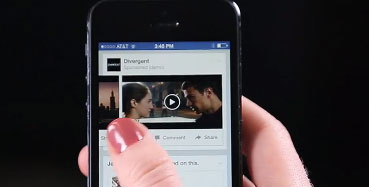This article about Facebook premium video ads is from the Mindshare Original Thinker Series.
After nearly a year of anticipation, Facebook is finally launching its long-awaited new video ad format following limited beta testing in Q4 2013. Video ads will start appearing in the Facebook newsfeed starting in April, thus bringing closure to a very lengthy and complicated product launch. The ad unit's initial launch date was delayed several times due to the ad unit's apparent superiority to the native content experience. Facebook senior management, including Zuckerberg himself, was apparently reluctant to disappoint users and show any bias to the advertising community.

Facebook walks a very fine line with the launch of this new ad unit. On one hand a new video unit will help it capitalize on the growing migration of TV AV spend to the Internet. Facebook's recent quarterly results have pleased Wall Street; continuing such stellar growth will require new sources of media investment, and online video is certainly one such source.
However, Facebook will also need to carefully monitor reaction from its users. Any backlash will further fuel rampant but largely unproven industry speculation and discussion around a user exodus, particularly amongst fickle teens. In response, Facebook will likely limit the number of campaigns and brand's in the US during 2014 as testing continues. Ad frequency is also capped at one ad per user per day; a user should not see more than one video ad in their newsfeed on any given day.
Details
The new video advertising unit will automatically play without sound. Auto-play begins when the user scrolls through the newsfeed and the video comes into view. Time-length of the ad is limited to 15 seconds. Once the user clicks to play, sound is initiated. Two subsequent carousels are also available, which can house additional video creative up to 15 minutes in length. Each brand will be entitled to a maximum of three 15 second creative executions per buy. These spots are not currently permitted to be split across a portfolio but are limited to a single brand per buy.

Facebook is heavily involved in the creative process in an attempt to make the ads as non-disruptive as possible. The emphasis is on enhancing the user experience as opposed to completely disrupting it – a tough balancing act to achieve, particularly given the massive amount of mobile users. For the initial beta campaigns, video ads had to be approved at the highest level by Facebook. Going forward Facebook Creative Consultants will provide creative guidelines and be part of the asset development process. A video will not go live on Facebook in the early days without Facebook approval on the creative.
Demographic targeting is limited to broad Nielsen Online Campaign Ratings classifications.
Eg: In a recent study, Nielsen Online Campaign Ratings measured a campaign for a beauty care brand that was hoping to improve its image among younger women (Figure 1). The advertiser designed a campaign focused on women 18-34 and ran 213 million impressions across 14 websites and ad networks for a six week period. Nielsen analysis showed that 33 percent of these impressions reached the desired audience (W 18-34), while 40 percent of the impressions were served to men. Clearly, these figures were disappointing to the advertiser. They never expected the campaign to deliver more impressions to men than their young female audience!

Video ads cannot currently be targeted based on other audience factors e.g., language, interests, behavior, etc. unlike other Facebook units. Video will not be accessible via FBX (Facebook exchange). As the platform evolves we would also expect to be able to buy against demo plus interest, making the video targeting space more robust, as well as potential inclusion in FBX.
Implications
A level of scale is being offered in an area where quality video inventory has been traditionally scarce online, albeit in a social versus premium content setting. That the video doesn't play until in view supports advertisers with objectives of increasing the percentage of viewable ad experiences for their audiences. The creative experience can be in-depth and also acts as a forum for longer form content; traditionally a tough paid format to effectively place although interaction potential is still unknown. The audience being guaranteed against OCR also gives Facebook a competitive edge over Google; YouTube has yet to fully embrace OCR.
Pricing points may be prohibitive for many advertisers; this new ad space is not cheap. Facebook will argue and seek to prove that when contrasted with a cluttered TV environment, an exclusive Facebook newsfeed emotive ad may prove to be a more impactful and effective investment. Other than media cost, the next biggest barrier is likely to get creative agencies and clients organized far enough in advance to go through a ridged creative approval process. Most creative agencies don't start ideation with Facebook consent in mind.

